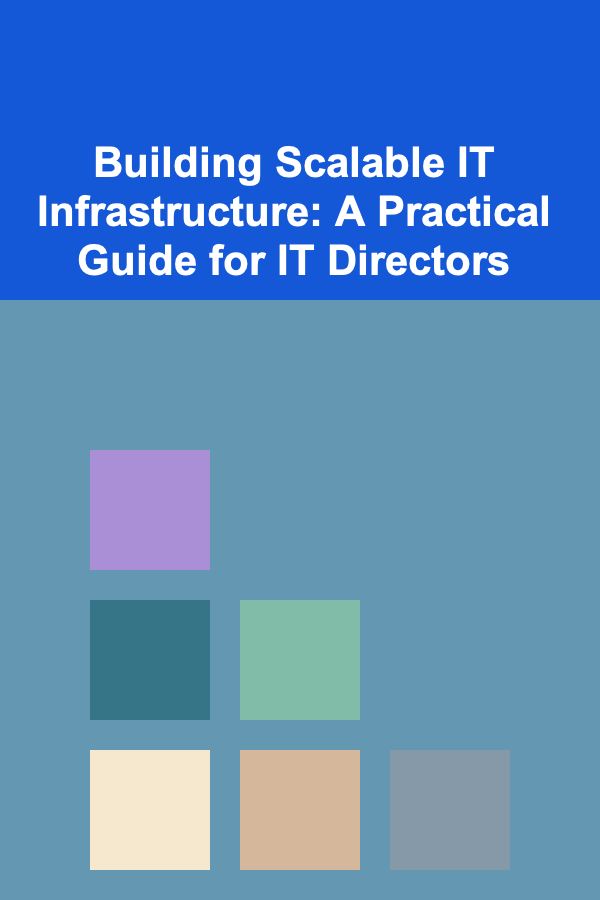
Building Scalable IT Infrastructure: A Practical Guide for IT Directors
ebook include PDF & Audio bundle (Micro Guide)
$12.99$7.99
Limited Time Offer! Order within the next:

In today's fast-paced, technology-driven world, businesses are under constant pressure to adapt quickly to changing market conditions and user demands. As an IT director, your role is crucial in ensuring that the organization's IT infrastructure is flexible, reliable, and scalable. Building a scalable IT infrastructure is not just about adding more servers or bandwidth; it involves creating a robust foundation that can grow efficiently as the company expands, without compromising performance or security.
In this guide, we will explore the key concepts, best practices, and actionable strategies to help you build a scalable IT infrastructure that can support the evolving needs of your organization.
Understand the Basics of Scalability
Before diving into the technical aspects of building a scalable IT infrastructure, it's important to understand what scalability means in the context of IT systems.
Scalability refers to the ability of an IT system, network, or application to handle a growing amount of work, or its potential to be enlarged to accommodate that growth. In practical terms, scalability allows your infrastructure to grow without requiring a complete redesign. There are two primary types of scalability to focus on:
- Vertical Scalability (Scaling Up): This involves adding more power to an existing server or system (e.g., upgrading CPU, RAM, storage) to handle increased demand. Vertical scaling is often simpler but can be limited by the hardware's capacity.
- Horizontal Scalability (Scaling Out): This involves adding more servers or machines to distribute the workload, which allows for greater flexibility and redundancy. Horizontal scaling is often preferred for cloud-based systems and large-scale applications.
In your role as an IT director, your goal is to design an infrastructure that can scale both vertically and horizontally as required, allowing for seamless growth and efficient resource management.
Choose the Right Architecture
The foundation of any scalable IT infrastructure is its architecture. As an IT director, you need to carefully consider the structure of the systems, networks, and data flows to ensure that scaling is possible in the future.
Cloud vs. On-Premises
One of the first decisions you'll need to make is whether to use on-premises infrastructure, cloud services, or a hybrid approach.
- On-Premises Infrastructure: Traditional, physical servers and hardware that you manage and maintain internally. This gives you full control but can be costly and challenging to scale.
- Cloud Infrastructure: Cloud platforms like AWS, Azure, and Google Cloud offer flexible, on-demand resources that can be scaled up or down as needed. Cloud environments often provide built-in tools to automate scaling and resource management.
- Hybrid Infrastructure: A mix of on-premises and cloud infrastructure, allowing you to leverage the best of both worlds. This approach is often used by organizations with specific data security or regulatory requirements.
For most modern businesses, cloud infrastructure is the preferred choice for scalability due to its flexibility, cost-effectiveness, and the ease with which resources can be adjusted as needed. A hybrid model can be useful for businesses with legacy systems or sensitive data that must remain on-premises.
Microservices Architecture
In addition to choosing the right infrastructure, consider using a microservices architecture for your applications. Microservices break down large, monolithic applications into smaller, independent services that can scale individually. This allows for more granular control over resource allocation and scaling.
For example, if a specific service is experiencing high demand, it can be scaled independently without affecting the other parts of the system. This is particularly valuable in modern cloud-based environments, where elasticity is key.
Adopt Automation and Orchestration
Scalability doesn't just mean adding hardware or software---it also requires managing resources efficiently. Automation and orchestration are critical for maintaining performance as your IT infrastructure scales.
Infrastructure as Code (IaC)
Infrastructure as Code (IaC) is a practice where infrastructure is provisioned and managed through code, allowing for automated deployment and configuration of resources. Tools like Terraform , Ansible , and CloudFormation enable IT teams to define and manage infrastructure in a repeatable and consistent way. IaC is a fundamental principle for scaling infrastructure quickly and efficiently, as it reduces human error and improves the speed of deployment.
Auto-scaling
Auto-scaling is a critical component for cloud environments. Cloud platforms allow you to configure auto-scaling rules that automatically adjust the number of active instances (servers or containers) based on the load. For example, if traffic to your website spikes, auto-scaling can automatically launch additional instances to handle the demand and scale down when traffic decreases.
Actionable Tip: Implement auto-scaling policies to ensure that resources are allocated efficiently. Set thresholds based on CPU usage, memory usage, and network traffic to ensure that the system scales in real-time as demand fluctuates.
Continuous Integration and Continuous Deployment (CI/CD)
Implementing CI/CD pipelines is another important strategy for scaling infrastructure. CI/CD ensures that changes to the system are automatically tested, integrated, and deployed without requiring manual intervention. By automating these processes, you can quickly roll out new features, bug fixes, and security patches while minimizing the risk of downtime.
Ensure Robust Security and Compliance
Scalability should not come at the expense of security. As your infrastructure grows, so does the potential attack surface for cyber threats. Implementing a scalable, secure infrastructure requires a holistic approach to security, integrating it into every aspect of your design and operations.
Network Security
Ensure that your network is segmented into layers to prevent unauthorized access and contain potential breaches. Use firewalls , VPNs , and intrusion detection systems (IDS) to protect sensitive data and services.
Actionable Tip: As your infrastructure grows, use network segmentation to limit access to sensitive data and prevent lateral movement within your network.
Identity and Access Management (IAM)
A scalable IAM solution ensures that access to resources is controlled and monitored. Tools like Azure Active Directory or AWS IAM allow you to define roles and permissions for users and applications, ensuring that each entity has access to only the resources they need.
Actionable Tip: Implement least privilege access policies to minimize security risks. As your infrastructure scales, regularly audit access permissions to ensure that they remain appropriate.
Data Security and Backup
As data grows, so does the need to secure it. Use encryption to protect data at rest and in transit, and implement regular backup strategies to prevent data loss.
Actionable Tip: Implement a multi-region backup strategy in the cloud to ensure that your data is protected from localized failures. Regularly test backups to verify their integrity.
Compliance
Ensure that your infrastructure complies with relevant regulations, such as GDPR , HIPAA , or PCI-DSS, depending on your industry. Compliance requirements may impact how you store and process data, and failure to comply could result in significant penalties.
Actionable Tip: Use cloud providers who offer built-in compliance tools and certifications to simplify the compliance process.
Monitor and Optimize Performance
Once your infrastructure is in place and scalable, the next step is to continuously monitor and optimize performance. Scaling should be a dynamic process that adapts to the changing needs of your business.
Monitoring Tools
Use monitoring tools such as Prometheus , Grafana , Datadog , and New Relic to track the performance of your infrastructure. These tools provide insights into server utilization, application performance, and network traffic, helping you identify potential bottlenecks before they affect performance.
Actionable Tip: Set up alerts for key metrics such as CPU usage, memory usage, and network traffic, and use predictive analytics to identify patterns and potential issues before they occur.
Cost Management
Scalable infrastructure often comes with the challenge of managing costs. Cloud environments, in particular, can become expensive if not properly managed. Use cost optimization tools offered by your cloud provider (such as AWS Cost Explorer or Azure Cost Management) to monitor usage and spend. Implementing resource tagging and monitoring idle resources can help you reduce unnecessary expenses.
Actionable Tip: Use reserved instances or savings plans for long-term workloads to reduce cloud service costs. Regularly review and optimize your infrastructure to avoid overprovisioning.
Plan for Disaster Recovery
As you scale your IT infrastructure, it's essential to plan for unexpected events such as natural disasters, cyberattacks, or hardware failures. A disaster recovery plan (DRP) ensures that your business can continue operations in the event of a failure.
Multi-Region and Multi-Availability Zone Deployments
Cloud providers offer the ability to deploy your infrastructure across multiple regions or availability zones to ensure redundancy and high availability. In the event of a failure in one region, traffic can be automatically routed to another region.
Actionable Tip: Use failover and load balancing techniques to ensure that your services remain available even during a disaster.
Regular Testing
Regularly test your disaster recovery procedures to ensure that they work as expected. This includes testing data restoration, application recovery, and failover procedures.
Actionable Tip: Conduct disaster recovery drills at least once a year to identify potential weaknesses in your plan and improve response times during an actual disaster.
Conclusion
Building a scalable IT infrastructure is not a one-time project but an ongoing process that requires foresight, planning, and continuous improvement. As an IT director, you must design systems that can grow with your organization, adapt to changing needs, and maintain security and performance at scale. By adopting the right architecture, automation tools, security practices, and monitoring strategies, you can create an infrastructure that supports your organization's growth and long-term success.
By focusing on scalability from the start, you ensure that your infrastructure is prepared for whatever challenges the future may bring.
Reading More From Our Other Websites
- [Personal Care Tips 101] How to Use Lip Balm to Combat Lip Wrinkles and Fine Lines
- [Skydiving Tip 101] Emergency Procedures: What Every Skydiver Should Do When Things Go Wrong
- [Personal Care Tips 101] How to Use Hair Serum to Add Shine to Your Hair
- [Home Holiday Decoration 101] How to Transform Your Living Room with Cozy Holiday Decor for an Enchanting Atmosphere
- [Needle Felting Tip 101] How to Achieve Seamless Color Transitions in Large‑Scale Needle Felting Landscape Murals
- [Personal Investment 101] How to Develop AI-Powered Tools for Recurring Revenue
- [Home Cleaning 101] How to Clean and Organize Your Junk Drawer
- [Home Staging 101] How to Decide if a Home Staging Franchise is the Right Career Path for You
- [Home Soundproofing 101] How to Maximize Soundproofing in Older Homes
- [Home Budget 101] How to Set Up a Budget for Debt Repayment

How to Use Checklists for Home Organization
Read More
How to Use Stackable Bins for Maximum Drawer Space
Read More
What Steps Can You Take to Organize Your Pantry by Category?
Read More
How To Develop Your Personal Leadership Style
Read More
The Art and Science of Perfect Soft-Boiled Eggs
Read More
10 Tips for Running Successful Hockey Scrimmages
Read MoreOther Products

How to Use Checklists for Home Organization
Read More
How to Use Stackable Bins for Maximum Drawer Space
Read More
What Steps Can You Take to Organize Your Pantry by Category?
Read More
How To Develop Your Personal Leadership Style
Read More
The Art and Science of Perfect Soft-Boiled Eggs
Read More